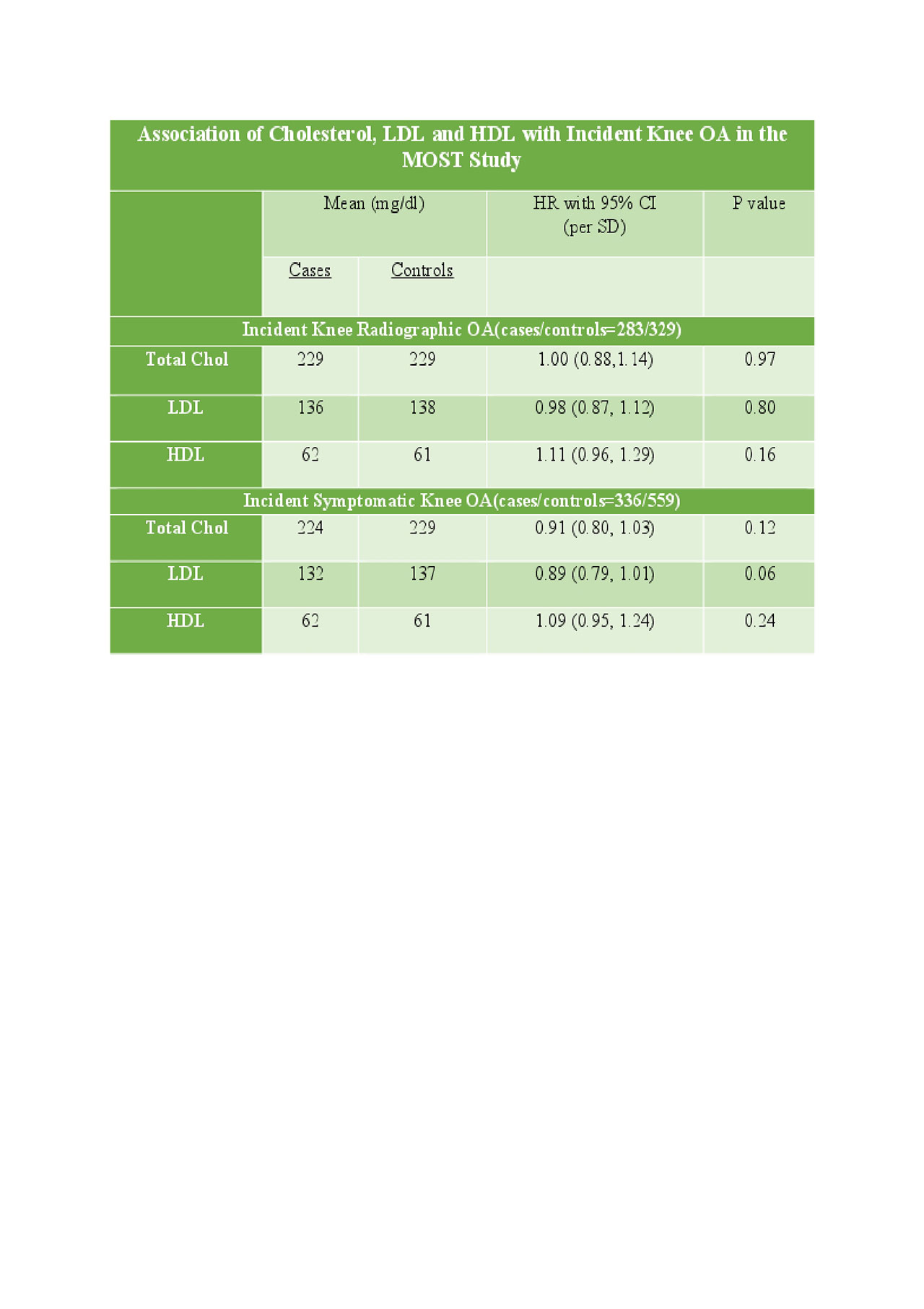Session Information
Session Type: Poster Session (Tuesday)
Session Time: 9:00AM-11:00AM
Background/Purpose: Recent data have suggested an association between elevated serum cholesterol levels, particularly low density lipoprotein (LDL), and the development of osteoarthritis (OA). Within the joint, circulating LDL is taken up by the synovium and oxidized, activating macrophages and leading to the release of inflammatory mediators. Further, mice with high LDL levels have high rates of OA compared with controls. In this study, we sought to comprehensively and longitudinally evaluate whether circulating total cholesterol, LDL, and high density lipoprotein (HDL) are associated with the risk of radiographic and symptomatic knee OA. We hypothesized that elevated levels of LDL increase the risk of developing knee OA.
Methods: We performed a nested case control study within the Multicenter Osteoarthritis study (MOST) cohort to examine the relationship between total cholesterol, LDL, and HDL and OA. MOST is an NIH-funded longitudinal study which followed 3,026 subjects with or at risk of developing OA for a seven year period, during which knee x-rays and MRIs were obtained and knee symptoms were queried at baseline, 30, 60, and 84 months. Baseline fasting blood samples were also drawn. We defined cases as those developing either radiographic OA (on plain film x-rays, N=283) or symptomatic OA (knee pain and radiographic OA, N=336) at follow-up. To identify cases with incident radiographic OA, we excluded those with prevalent radiographic OA at baseline and then followed subjects for the development of incident disease. Controls were selected randomly from those who were eligible to develop OA but did not. We carried out an identical case and control selection procedure for incident symptomatic OA. Additionally, we examined cartilage loss and synovitis on MRI and knee pain using the WOMAC scale. We carried out person-specific analyses using Cox Proportional Hazards regression adjusting for age, sex, BMI and educational attainment. When analyzing pain outcomes, covariates included depressive symptoms. We tested cholesterol as a continuous measure and did sensitivity analyses examining whether commonly used thresholds for high cholesterol ( >=200mg/dl), LDL ( >=130 mg/dl) or low HDL (< =60mg/dl) increased risk.
Results: Mean age at baseline was 62 years and 55% were women. The hazard ratio for incident radiographic OA and incident symptomatic OA according to total cholesterol, LDL, and HDL cholesterol levels as well as the mean cholesterol values showed no significant associations with OA (see table). Additionally, we found no significant association of total cholesterol, LDL and HDL with cartilage loss, worsening synovitis or worsening knee pain. We also examined whether persons with high cholesterol, LDL or low HDL had an increased risk of OA, and did not find a significant association.
Conclusion: We did not find an association between LDL cholesterol, total cholesterol, or HDL cholesterol levels with incident osteoarthritis or other osteoarthritis outcomes. While LDL may have local deleterious effects on joint structure, elevated systemic levels do not confer risk of disease.
To cite this abstract in AMA style:
Barlow J, Sun X, Nevitt M, Torner J, Lewis B, Matthan N, Lichtenstein A, Felson D. Is There an Association of Serum LDL, HDL and Total Cholesterol with the Development of Knee Osteoarthritis? [abstract]. Arthritis Rheumatol. 2019; 71 (suppl 10). https://acrabstracts.org/abstract/is-there-an-association-of-serum-ldl-hdl-and-total-cholesterol-with-the-development-of-knee-osteoarthritis/. Accessed .« Back to 2019 ACR/ARP Annual Meeting
ACR Meeting Abstracts - https://acrabstracts.org/abstract/is-there-an-association-of-serum-ldl-hdl-and-total-cholesterol-with-the-development-of-knee-osteoarthritis/

